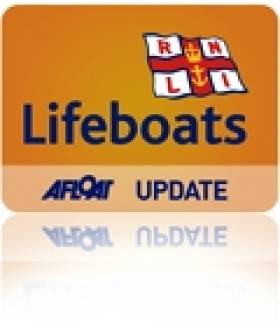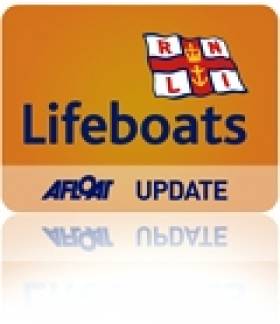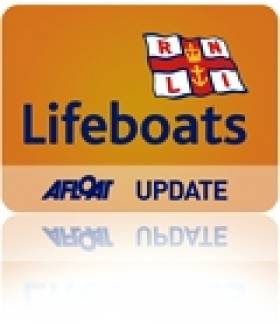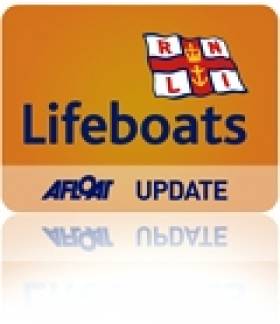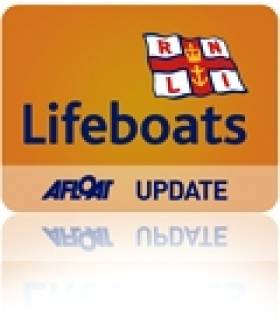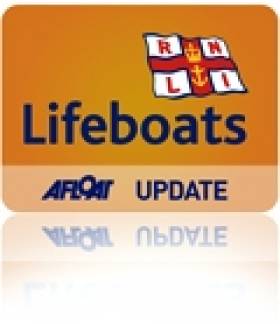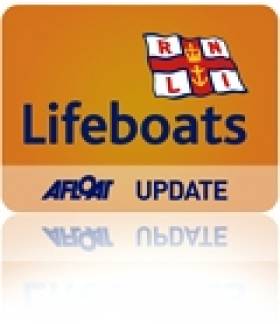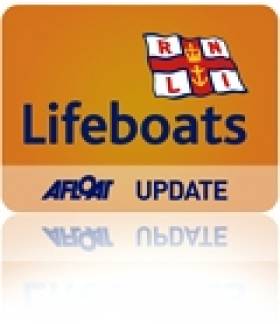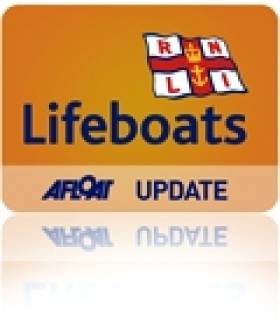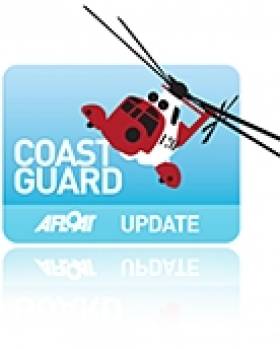Displaying items by tag: Lifeboats
Cold Swimmer Rescued in Portrush Harbour
After swimming across the harbour to the moored boat the teenager called for help. Belfast Coastguard co-ordinated the rescue and sent the Portrush ILB Lifeboat and the Coleraine Coastguard Rescue team to the scene.
The Portrush lifeboat took the teenager from the boat to the pontoon where he received first aid from the Coastguard Rescue team before being transferred to hospital by ambulance.
Belfast Coastguard Watch Manager Alan Pritchard said:
"It may be summer but the sea is chilly and the cold can seriously affect swimmers.
"If you are going to take a dip please know you're limits and remember cold water shock can be dangerous, even if you're young and fit and think you're able."
Related Safety posts
RNLI Lifeboats in Ireland
Safety News
Rescue News from RNLI Lifeboats in Ireland
Coast Guard News from Ireland
Water Safety News from Ireland
Marine Casualty Investigation Board News
Marine Warnings
Fenit Lifeboat Recover Injured Woman from Great Blasket Island
At 03.41 this morning (Thursday 5 August 2010) Fenit RNLI lifeboat crew were requested to launch by Valentia Coast Guard to go to the assistance of a woman injured on the Great Blasket Island. The woman had fallen and sustained injuries to her leg and the Fenit RNLI all weather lifeboat was launched to recover her from the island and bring her ashore to Dingle to a waiting ambulance.
With no slipway or pier on the island and extremely shallow water at the landing point, the only way for the lifeboat crew to access the island was by launching the XP boat (a small inflatable boat carried onboard the lifeboat)
Four crew members went onto the island and made their way to the woman's house which was almost half a mile in and about 600 feet above sea level. The task was made more difficult due to the fact that the ground was extremely wet and slippery.
The woman was placed on a stretcher and carried back down the hill by the RNLI Fenit Lifeboat crew members. The stretcher was then placed across the xp boat and transferred to the lifeboat by the crew.
Commenting on the incident JP Brick of Fenit RNLI said, " This was a challenging callout for the lifeboat crew. The remote location made it difficult to access the island. The lifeboat crew needed to take a stretcher with them for the casualty and then return down the slippery terrain to the waiting XP boat. From there they travelled out to the waiting lifeboat and transferred the casualty onboard. This is where lifeboat crew training and equipment comes to the fore and the medivac was completed successfully."
On medical advice the casualty was brought to Dingle Marina where she was collected by ambulance and transferred to Tralee General Hospital
Related Safety posts
RNLI Lifeboats in Ireland
Safety News
Rescue News from RNLI Lifeboats in Ireland
Coast Guard News from Ireland
Water Safety News from Ireland
Marine Casualty Investigation Board News
Marine Warnings
For the first time, the recently-formed Sea Safety team will also be on hand to offer advice to visitors on how best to prepare for trips afloat and boating activities.
Equipment demonstrations and model boat displays will also be part of the attractions including the station's All-Weather lifeboat (ALB). Crew-members, who operate on a fully-voluntary basis will be demonstrating various items of rescue equipment and the ALB " Anna Livia" will be alongside offering close-up views of this €2 million rescue craft.
There are two lifeboats at Dun Laoghaire, a Trent class ALB and a D-Class ILB (Inshore lifeboat) of the new IB1-type that was recently delivered to the 207-year old station and is based in the nearby historic boathouse at the East Pier. This lifeboat, named 'Realt Na Mara' , was funded by the genorisity of a family in Dublin. The station's shop selling souvenirs and other lifeboat-related items will also be open, helping to raise funds for the voluntary service.
The Sea Safety team, part of the RNLI's stated aim of improving safety at sea through education and information can also take bookings for the free 'Sea Check' service that assists boat-owners. The Dun Laoghaire RNLI station is one of 43 based in the Ireland division that operate 55 lifeboats that launched on 976 occasions and rescued 1,008 people in 2009.
Dun Laoghaire is regularly amongst the busiest and last year launched on 68 occasions and rescued 92 people. For more information, please visit http://www.dunlaoghaire-lifeboat.ie
Wicklow Lifeboat Launches Twice at the Weekend
Wicklow lifeboat launched at 10.07am on Sunday morning ( 25th July) to assist a 32 foot yacht with mechanical problems. The yacht was at located 11.00am 13 miles North East of Wicklow harbour becalmed and unable to motor. The lifeboat crew quickly established a towline and the yacht with 3 people onboard was taken back to Wicklow Harbour, the vessel was safely alongside the quay by 1.15pm and the lifeboat returned to station. Crew list - Coxswain Nick Keogh, Mechanic Lisa O Leary, Brendan Kavanagh Wayne Jones, John Docherty and Brian Sinnot.
A few hours later pagers were activated to alert the volunteer crew and the lifeboat put to sea again at 3.42pm, this time to give assistance to a rigid inflatable boat that had broken down with 5 people onboard near the Silver Strand. The lifeboat located the 5 metre Rib South of Wicklow head. 3 children were taken onboard the lifeboat and the Rib was towed back to Wicklow harbour, where all 5 people were landed safely.
Crew list: Coxswain Ciaran Doyle, Mechanic Lisa O Leary, Tommy McAulay , Barry Spencer, Tommy Murphy and John Docherty.
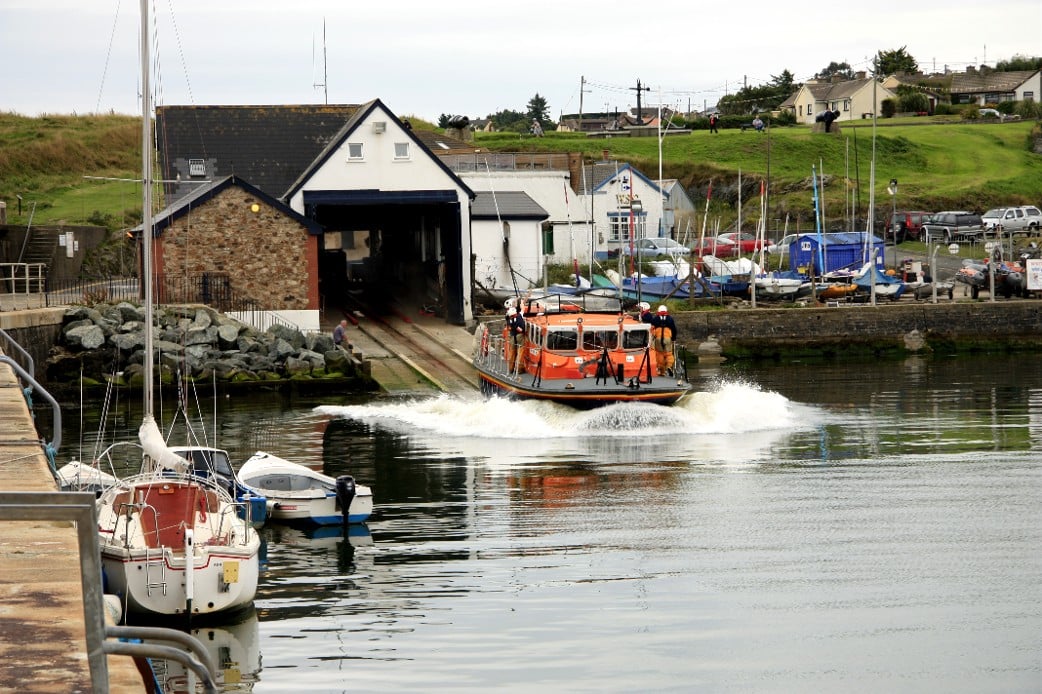
Wicklow Lifeboat Launches at the Weekend. Photo: courtesy Wicklow lifeboat
Related Safety posts
RNLI Lifeboats in Ireland
Safety News
Rescue News from RNLI Lifeboats in Ireland
Coast Guard News from Ireland
Water Safety News from Ireland
Marine Casualty Investigation Board News
Marine Warnings
Trawler Fouls Prop, Calls Lifeboat for Tow
Ballycotton lifeboat was called on to lend assistance to a 23 metre fishing vessel in difficulties, 31 miles south of Ballycotton today. The Irish registered vessel, with five on board, contacted the emergency services when they fouled their propeller. The Ballycotton lifeboat, Austin Lidbury, arrived on scene at 12:00 and established a towline. The vessel was safely towed to Ballycotton harbour.
Related Safety posts
RNLI Lifeboats in Ireland
Safety News
Rescue News from RNLI Lifeboats in Ireland
Coast Guard News from Ireland
Water Safety News from Ireland
Marine Casualty Investigation Board News
Marine Warnings
Castletownbere Lifeboat was launched this afternoon at 12.20pm to go to the assistance of a 43 ft fishing vessel taking on water 17 miles south west of Castletownbere in county Cork. To view the RNLI Video scroll down to the bottom of the post.
When the lifeboat crew arrived on scene they saw that the three crew had got into a liferaft as their fishing vessel was taking on a considerable amount of water and was in danger of sinking.
Conditions were described as fair with a large 4 metre groundswell. The Coast Guard helicopter from Shannon winched two of the fishing crew off the liferaft but a third man was in the water. Castletownbere lifeboat crew immediately recovered the man onto the lifeboat. With the casualty safely on the lifeboat, two RNLI crewmembers brought a salvage pump on board and proceed to pump the water from the fishing vessel. It was then taken under tow by the lifeboat and brought back to the harbour.
The rescued man did not need any further medical attention. The Irish Navel vessel the LE Eithne was also on scene during the rescue. Commenting on the callout Castletownbere RNLI crewmember Paul Stevens said, “ This callout thankfully resulted in a happy ending with three men being brought to safety. We were also able to bring the fishing vessel ashore in one piece. I am sure the three men are in shock but they had a lucky escape.”
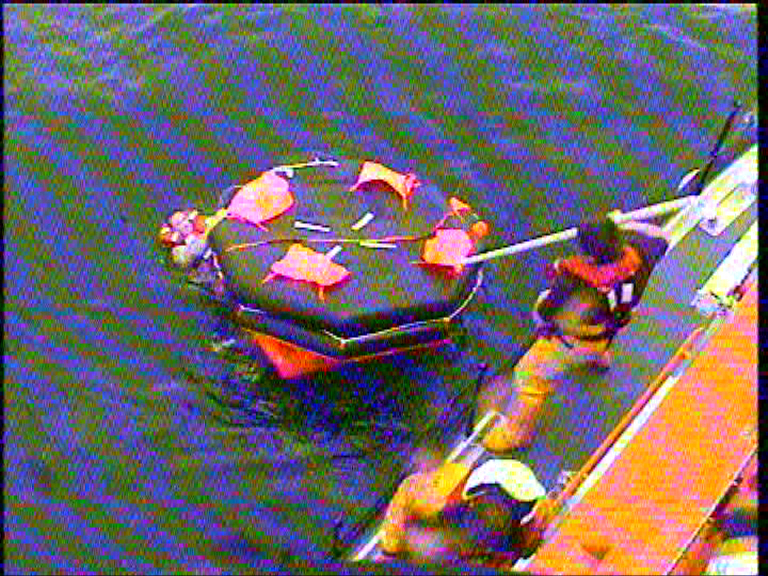
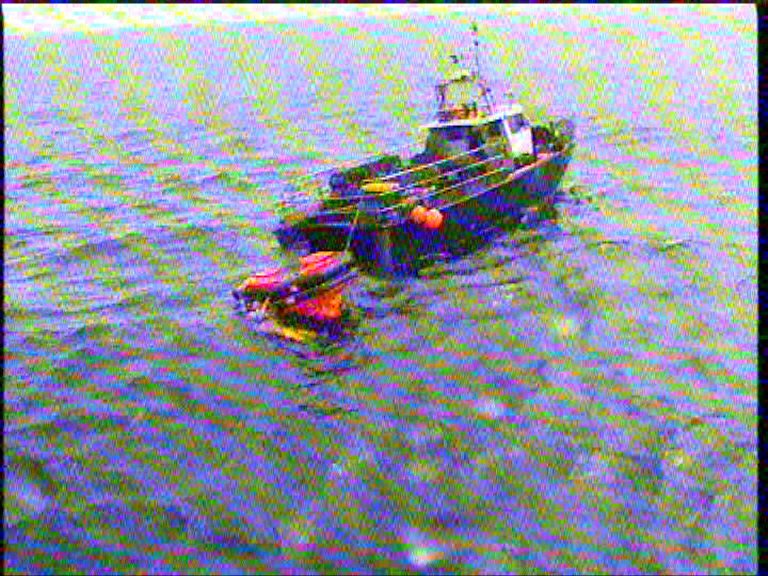
Related Safety posts
RNLI Lifeboats in Ireland
Safety News
Rescue News from RNLI Lifeboats in Ireland
Coast Guard News from Ireland
Water Safety News from Ireland
Marine Casualty Investigation Board News
Marine Warnings
Lifeboat Creates Wash to Assist Yacht Aground
Baltimore RNLI inshore lifeboat Bessie, was launched this morning to assist a yacht that had gone aground at an area called the Sound, North West of Baltimore Harbour. The alarm was raised at 11:52am when the 36ft Sun Odyssey yacht was seen aground across the Harbour. Helmsman Youen Jacob with his crew of Kieran Collins and John McDonagh made their way to the stricken vessel on an RNLI twin engine Atlantic 75 RIB. On arrival at the scene they found the crew hauling on their anchor line in an attempt to pull themselves off the rocks. The inshore lifeboat gave assistance by creating a wash which lifted the boat from its rocky perch. The lifeboat then escorted the yacht back to Baltimore Harbour. The yacht did not suffer any significant damage and all four passengers on board, two men and two women were uninjured.
Related Safety postsRNLI Lifeboats in Ireland
Safety News
Rescue News from RNLI Lifeboats in Ireland
Coast Guard News from Ireland
Water Safety News from Ireland
Marine Casualty Investigation Board News
Marine Warnings
At 5.45pm yesterday evening Monday July 5th, Fenit RNLI Lifeboat launched to assist a 40 foot Catamaran which was taking on water. The vessel which had left Donegal en route to France was 20 miles west of Loop Head and there were 2 people on board.
On arriving at the location of the stricken vessel volunteer crew members with Fenit RNLI Lifeboat immediately boarded the catamaran with a salvage pump and proceeded to pump the water from the vessel. Once they were happy that this process was working satisfactorily they put the vessel on tow and proceeded towards Fenit.
On arrival back in Fenit just before 1am this morning, arrangements were in place by Fenit RNLI members on shore and the catamaran was lifted onto the Pier by the Fenit Harbour Board Crane.
iPhone Co-Ordinates Save Stricken Vessel
A stricken vessel was located in trouble on Lough Erne using lat/long data from an iPhone.
A 999 call from the Motor Cruiser ‘Wee Rascal’ on Lough Erne in the early hours of this morning called on all the investigative powers of Belfast Coastguard as the vessel wasn’t even close to its reported position.
The vessel was on passage from Kesh to Enniskillen in windy, wet conditions when it called 999 to ask for assistance. Despite an extensive search of the area around its reported position neither the Enniskillen RNLI Inshore Lifeboat nor Erne Coastguard Rescue Teams could find the vessel.
Because the vessel had no flares, flash lights or VHF Radio on board to show rescuers where it was, Belfast Coastguard resorted to mobile phone technology. A locator i-phone application finally gave rescuers the vital latitude and longitude they needed to locate the vessel
The vessel was finally located 25 miles away from its reported position, dangerously amongst the rocky shoreline off Eagle Point. It was carefully brought away from the rocks by the skill of the Enniskillen RNLI Inshore Lifeboat crew and taken to the safety of Beleek marina.
Coastguard Watch Manager Steven Carson said:
“A combination of luck and technology saved these four people from imminent danger this morning. They had charts onboard but obviously no real idea of how to get to their destination or how to report their position in an emergency.
“Vital hours were wasted eliminating one possible location after another, time that we wouldn’t have had if the vessel had struck the rocks and sunk. I hope that this experience will help the crew to realise why navigation training is essential for all mariners, whether you’re on a Lough or the open sea.”
Lost Vessel Saved From Lough Erne Rocks
A 999 call from the Motor Cruiser ‘Wee Rascal’ on Lough Erne in the early hours of this morning called on all the investigative powers of Belfast Coastguard as the vessel wasn’t even close to its reported position.
The vessel was on passage from Kesh to Enniskillen in windy, wet conditions when it called 999 to ask for assistance. Despite an extensive search of the area around its reported position neither the Enniskillen RNLI Inshore Lifeboat nor Erne Coastguard Rescue Teams could find the vessel.
Because the vessel had no flares, flash lights or VHF Radio on board to show rescuers where it was, Belfast Coastguard resorted to mobile phone technology. A locator i-phone application finally gave rescuers the vital latitude and longitude they needed.
The vessel was finally located 25 miles away from its reported position, dangerously amongst the rocky shoreline off Eagle Point. It was carefully brought away from the rocks by the skill of the Enniskillen RNLI Inshore Lifeboat crew and taken to the safety of Beleek marina.
Coastguard Watch Manager Steven Carson said:
“A combination of luck and technology saved these four people from imminent danger this morning. They had charts onboard but obviously no real idea of how to get to their destination or how to report their position in an emergency.
“Vital hours were wasted eliminating one possible location after another, time that we wouldn’t have had if the vessel had struck the rocks and sunk. I hope that this experience will help the crew to realise why navigation training is essential for all mariners, whether you’re on a Lough or the open sea.”


























